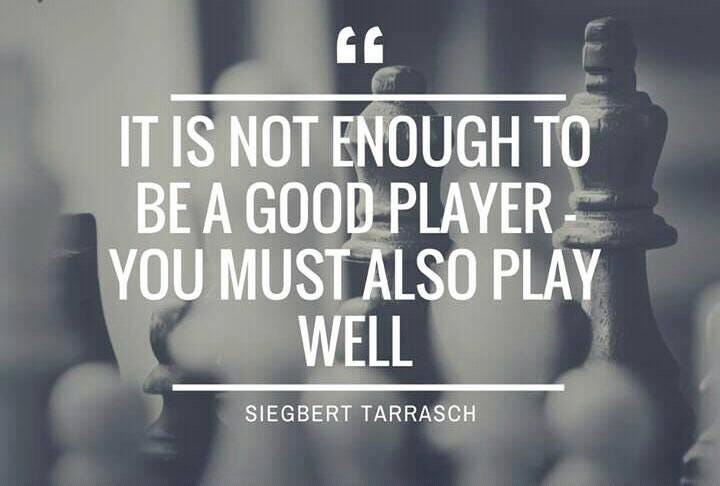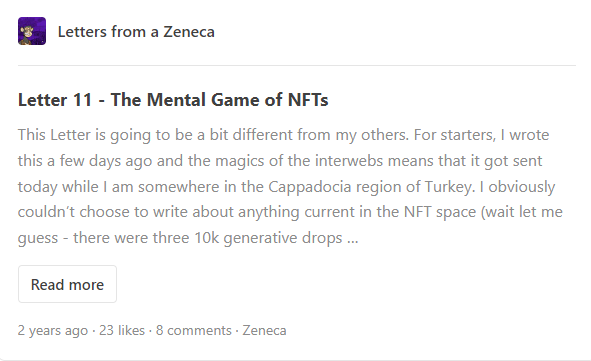Bankroll Management, Probabilistic Thinking, Tilt, and More
For those who don’t know, I was a professional poker player for 17 years before getting into crypto. There are a lot of professional poker players that make the transition. It’s no surprise. There are so many parallels between the two worlds, and the experience garnered from succeeding at poker is extremely useful for succeeding in crypto too.
In this Letter we’ll cover:
- Bankroll Management
- Probabilistic Thinking
- Tracking Results
- Using Tools
- Minimizing Tilt
Let’s jump right in.
Bankroll Management
Arguably the most important. Many of you will have heard me say a hundred times (including in my previous Letter):
The only thing you need to do to thrive in this space, is survive this space.
While not strictly true, it’s close enough.
Effective Bankroll Management is the strategy you need to understand and employ to ensure that you survive.
In poker, the thinking goes something like this:
Let’s say you have a total of $5,000 in dispensable money that you are willing to allocate into your “poker bankroll”. You’re comfortable risking/losing that amount, but you can’t/don’t want to add any more to it in case you lose it all.
The LAST thing you want to do is sit down at a table with all $5,000. One single unlucky hand, one bad beat, and you lose it all, even if you play perfectly. This is because there are forces outside your control that impact the results (luck). What you should do is buy into games with a much lower buy-in.
It’s been a while since I have played but back in my day, conventional wisdom suggested a minimum of 20 buy-ins, usually more. 50 buy-ins was not unreasonable, and 100 was probably at the more conservative end. It varied depending on the stakes, your ability to move down in stakes, and how able you were to replenish your bankroll.
Assuming an average/modest strategy (50 buy-ins), with a Bankroll of $5k you would only want to play a table that has a $100 buy-in. If you lose it all, no big deal, you can re-buy and try again, or move to another table and try again. You’re not risking the opportunity cost of losing and being unable to continue to play.
Bringing it back to crypto and NFTs, let’s assume you have $5,000 or 3 ETH to play with (or 1 ETH.. he says, wistfully remembering 2021; insert tear drop emoji). The LAST thing you want to do is go and put all of it into one coin, or one NFT. We’ve seen single projects implode a million times over, and there are forces outside of anyones control that will continue to make that happen, over and over.
Instead, you should be allocating significantly smaller amounts to each “bet” you make on a project. Consider mentally divvying up 3 ETH into 50 buy-ins of approximately 0.06 ETH each. It’s probably okay to buy one or even 2x/3x of a project at that price point, b/c if it goes to hell you’re still gonna be in the game.
Another part of BR management is remaining liquid. Just because you have 3 ETH to work with, doesn’t mean you should immediately (or ever) deploy all 3 ETH into projects. This is how you miss out on fantastic opportunities that come up out of nowhere. There’s nothing worse than seeing an AMAZING opportunity that you need 0.2 ETH to capitalize on and being unable to because you’re tapped out.
I could go on about BR management and I have only just scratched the surface here. Here’s a decent article for further reading: https://www.pokernews.com/strategy/an-introduction-to-bankroll-management-19610.htm.
Probabilistic Thinking
This is basically thinking in terms of odds and probabilities. It might seem scary if you’re not “good at math”, but trust me, you don’t need to be. You don’t need to understand anything complex, and it’s more of a way-of-thinking than an exact science anyway.
The idea is that nobody can ever know for certain what will happen in the future. We can be 99.999999999999999999999999999999999999999999999999999999% sure that the sun will rise tomorrow, so we round that to 100%, but in reality, there’s always some minuscule chance that something impossible will happen.
Ever read a weather forecast that says it’s gonna rain tomorrow, and then it doesn’t? Or that it won’t, and then it does? That’s just meteorologists using probabilistic thinking. It’s not an exact science.
Ever watched a sportsballgame where one team were the massive favourites, but then lost? Stubborn people who don’t understand probabilities might have said something like “there’s NO WAY that xxxx team is gonna lose tomorrow, nope, not gonna happen”. Someone a little savvier might have gone “well, there’s maybe a 2% chance that they lose.. and wow the odds are 200-to-1 to bet on the other team.. that’s an opportunity!”
Poker was EXCELLENT at teaching me about this. Every single decision you have to make at every point in a hand is an exercise in probabilistic thinking. I did it (almost) all day, (almost) every day, for over a decade. Many people think poker is about trying to pick the exact hand your opponent has — it’s not. It’s about putting them on a range of hands, assigning percentages to each possible hand within that range, and then acting accordingly.
When it comes to NFTs it’s the same. Nobody knows what’s gonna happen with the market, let alone an individual project. Sure, a lot of us have tremendous conviction that, long term, crypto will go up a lot. But even then, there’s a % chance that everything goes to absolute zero. Let’s look at an example:
Let’s say the hottest project of the day is up 8x this week. Everyone is talking about it. You’re feeling massive FOMO. You might want to buy in. Let’s look at a reasonable analysis of what might happen:
There’s a 10% chance it goes up a little further
There’s a 10% chance it goes up another 2x
There’s a 20% chance it stabilizes
There’s a 20% chance it pulls back slightly
There’s a 40% chance it drops significantly in price
It’s pretty easy and clear to see that you shouldn’t be buying at this point (you should use this framework, ideally, for every single decision you make).
Then you can place your bets accordingly, and manage your bankroll accordingly.
For a MUCH better and more in-depth explanation of it all, read this fantastic article by Cobie on this topic:
Tracking Results
This is an easy one but SO important. In poker it is commonplace to track not only your general results (P&L per session/day/month/year) but also to track every individual hand. Online poker sites automate the process by creating a “hand history” file, and there are countless pieces of software that can import these files to make tracking even easier.
The important part about hand histories is not necessarily the collective metrics they provide, but the ability to look at an individual hand and break down every decision you made, and evaluate whether you could have done something different/better. Generally it’s great to show this HH to friends and get multiple perspectives.
It’s a bit easier to do with poker because a) all that fantastic software exists and b) it’s a game with defined rules so it’s easier (relatively) to evaluate whether someone played a hand “well” or “poorly”.
In crypto it’s much more difficult because there’s infinity more variables at play, and everyone is working with infinity different levels of information.
Still, it’s tremendously helpful and worth tracking your trades. You’ll be able to spot patterns, ie “oh wow I am losing money almost every time I buy on secondary, I should maybe just stick to minting only” or “I seem to constantly sell too early and leave money on the table, perhaps I should list a bit higher on everything to try and secure more profits”.
The best way to track your trades? Honestly, probably an excel/google spreadsheet. Yes it takes some time and effort but my god will it be worth it.
My goal is to write 52 Letters this year and provide as much free value as I can to anyone looking to thrive in 2023. Join 23,000+ readers to be along for the best year ever.Subscribe
Using Tools
This can be a contentious topic. Tools can mean various things. In poker, there are things like PokerTracker and HoldemManager which not only track your history/results, but provide a real time HUD of opponent’s stats which you can use to influence your decisions. In the early days some people used them and some didn’t, and both camps could be tremendously successful.
Today, it’s almost impossible to be successful without using sophisticated tools. There are now “solvers” that use game theory to figure out the most optimal decision in every situation.
One big difference between online poker and most of crypto is that of centralization. Poker sites would ban certain tools (ie bots that played for you) and it was an endless cat and mouse game, where if you were caught, you risked having your accounts banned and assets confiscated. In web3, there’s generally no centralized entity trying to punish people who bot. Yes, people are trying to implement “anti-bot” measures, but given there’s no real punishment for people who use them, I don’t think bots are going anywhere.
If you can’t beat em, join em? I dunno. There are moral and ethical issues at stake too. This is a larger conversation than the scope of this Letter, but it’s worth at least contemplating setting up your own bot(s) to help navigate this space. I personally have never used one but that’s probably b/c most of my trading happened in 2021 when they were far less commonplace.
“Tools” doesn’t start/end with just bots. There are so many other tools that you should be using, that are much less morally murky. NFTNerds for charts, CatchMint for finding the latest things minting, Blur for the fastest marketplace + aggregator, IcyTools/Moby/Nansen/Parsec and so many more for so many more reasons.
PocketUniverse is great for protecting yourself, BlockNative is great for keeping tabs on gas.
The list goes on. Invest some time and money into learning about the best tools in the space, you won’t regret it.
Minimizing Tilt
Last but certainly not least.
Tilt is a poker term for a state of mental or emotional confusion or frustration in which a player adopts a suboptimal strategy
Or in other words (one of my favourite quotes):
Most people do not currently have the temperament to be able to stay rational and make good decisions when they’re being battered by the elements of an irrational market. Most people, when losing a lot of money, or missing out on making a lot of money, will feel sad, upset, angry, distressed, tilted.
It’s pretty normal. It’s also pretty disastrous to make important financial decisions when you’re in such a state. Fortunately, it’s possible to train your mind to get better at staying emotionally stable. With time and experience, a bit of reflection and conscientiousness, and a solid dose of logic, I believe anyone can significantly improve their mental game and reduce the frequency and severity of their tilt.
I have written on this topic twice before, so rather than rehashing them, I encourage you to read two of my personal favourite previous Letters:
Disclaimer: The content covered in this newsletter is not to be considered as investment advice. I’m not a financial adviser. These are only my own opinions and ideas. You should always consult with a professional/licensed financial adviser before trading or investing in any cryptocurrency related product.







